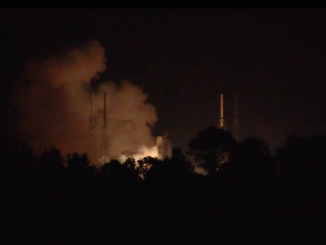
Chinese scientists and engineers are counting down to launch of a heavy-lift Long March 5 rocket Monday with the Chang’e 5 mission, an ambitious attempt to land on the moon, drill samples from beneath the lunar surface, and return the material to Earth.
The mission is set for launch around 3:35 p.m. EST (2035 GMT) from the Wenchang space center on Hainan Island, China’s newest spaceport, according to the European Space Agency, which is providing communications and tracking support for Chang’e 5.
The nearly 20-story Long March 5 rocket — the largest rocket in China’s fleet — will send the Chang’e 5 spacecraft on a trajectory toward the moon, where it will enter orbit before releasing a landing craft to descend to the lunar surface.
The exact timeline for the mission has not been released by Chinese officials, but the lander is expected to touch down near Mons Rümker, a volcanic formation that extends more than 4,000 feet — or about 1,300 meters — above the surrounding lava plains.
Chang’e 5’s landing site is located in the Oceanus Procellarum, or Ocean of Storms, region in the northern hemisphere of the near side of the moon.
Once on the moon, Chang’e 5 will extract up to 4.4 pounds, or 2 kilograms, of material from a depth of up to 6.6 feet, or 2 meters, below the surface. Then the specimens will launch back into lunar orbit aboard a small rocket, rendezvous with a return craft, and head for Earth.
The return carrier will re-enter the atmosphere at some 25,000 mph, or 40,000 kilometers per hour, significantly faster than a re-enter from low Earth orbit. The capsule will will land around Dec. 15 in China’s Inner Mongolia region, where teams will retrieve the moon specimens and transport the material to a lab for analysis.
The sample return mission, if successful, will mark the first time lunar material has been returned to Earth since 1976, when the Soviet Union’s robotic Luna 24 mission brought back around 170 grams, or 6 ounces, of specimens from the lunar surface.
Nine missions have returned moon samples to Earth, including NASA’s six Apollo missions with astronauts, and three robotic Luna spacecraft launched by the Soviet Union.
Before Chang’e 5, China has successfully dispatched four robotic explorers to the moon, beginning with the Chang’e 1 and Chang’e 2 orbiters in 2007 and 2010. In 2013, China landed the Chang’e 3 mission on the moon with a mobile rover that drove across the lunar surface.
China’s most challenging lunar mission to date was Chang’e 4, which accomplished the first-ever soft landing on the far side of the moon in January 2019. Chang’e 4’s rover continues operating, sending back imagery and scientific data through a dedicated relay satellite China placed in a position beyond far side of the moon to transmit signals between Earth and the Chang’e 4 spacecraft.
The Chang’e missions are named for a moon goddess in Chinese folklore.
China has a backup to the Chang’e 5 spacecraft named Chang’e 6. If Chang’e 5 is successful, Chang’e 6 could attempt a sample return mission from the far side of the moon.
Unlike Chang’e 5, which is an all-Chinese mission, the Chang’e 6 spacecraft will carry foreign instruments to the lunar surface. The French space agency, CNES, announced last year that it will provide an instrument for the Chang’e 6 mission to study the moon’s exosphere and water cycle.
China is also planning a robotic station on the moon’s south pole before a possible landing on the moon with Chinese astronauts in the 2030s.
Chinese officials have signaled they are open to partnering with other countries on lunar exploration. Instruments developed by scientists in Sweden, Germany, and Saudi Arabia have flown to the moon on past Chinese mission.
Email the author.
Follow Stephen Clark on Twitter: @StephenClark1.



